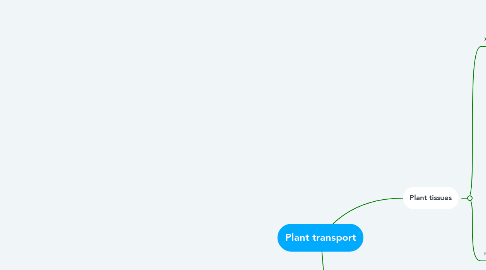
1. Plant tissues
1.1. Xylem
1.1.1. It is a nonliving vascular vessel, continuous (tracheas) whose walls are thick and contain a chemical called lignin. This material hardens the cells walls of the plants. Besides that, there is no end walls between the cells.
1.1.2. This tissue transports water and minerals from the roots to other parts of the plant
1.1.3. How do the substances travel through the xylem?
1.1.3.1. Transpiration pull: The pulling force developed inside the xylem tissue causing the water to move up the xylem vessel and, in this way, water vapor leaves the leaves
1.2. Phloem
1.2.1. Living vascular vessel which contain a cytoplasm, unlike xylem
1.2.2. A column of a phloem cells in a plant are called sieve tubes. This columns are divided in sieve-tube members by sieve plates. This are porous walls that allows fluids to pass through the cells. Next to the sieve-tubes members there are a companion cells. Even thought its function is uncertain, it is possible that these cells are responsible for providing the sieve tube with some of their requirements.
1.2.3. This tissue transports sugars, such as sucrose, and amino acids throughout the plant
1.2.4. How do substances travel through the phloem
1.2.4.1. Translocation: The movement of organic compounds from the sources to the sink. The source is where the compounds are synthesized, in the photosynthesis (usually in the leaves) . The sink is where the compounds are delivered and then used or stored (usually roots fruits and seeds).
1.2.4.2. These organic compounds are transported to the sink via different kinds of transport. First, the organic compounds are moved from the source to the phloem using active transport. As the xylem position is adjacent to the phloem, the actively supported influx of sugar into the phloem results in the passive movement of water from the xylem where the organic compound concentration are low into the phloem where these compound's concentration are high. This process is know as osmosis.
1.2.4.3. As a result, fluid within the phloem is driven away from the source. This compounds are actively transported to the sink (mass flow) where these compounds can be used or stored.
2. Transpiration stream
2.1. What is transpiration?
2.1.1. The loss of water from the plant, in the leaves and the stem. It is caused by the evaporation and diffusion- the net movement of substances from a region of high concentration to a lower concentration region- of water vapor from a plant's surface
2.2. Water moves through the xylem vessels in a continuous transpiration stream. It goes from the roots hair, up to the root, to the stem and finally getting to the leaf. This pathway taken by water is called the transpiration stream
2.3. In other for transpiration occur, stomata, pored on the underside of the leaf, has to be open. It is required photosynthetic gas exchange for the stomata to be open. For this reason, transpiration will be affected by the levels of photosynthesis.
2.4. What are some of things that can influence transpiration?
2.4.1. Temperature; air movement; humidity; light intensity; levels of photosynthesis; others
